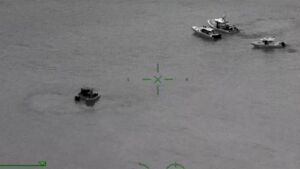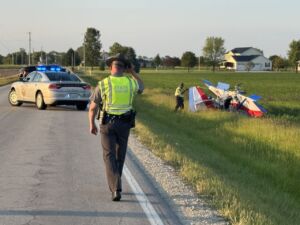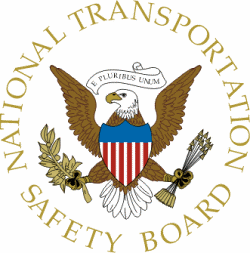These are your stories for today...
Two articles of note, the Fire Safety Research Institute issued a notice regarding a potential hazard involving fire blankets used for electric vehicle fire suppression efforts with battery involvement and the NTSB has a job opening for a Senior Survival Factors Investigator (Airport Operations and Crashworthiness).
Be safe out there!
Tom
3 people rescued after small plane crashes into Atlantic Ocean off Indian River County
Sheriff's office helicopter spots victims, guides rescue vessels to their position
By: Scott Sutton
INDIAN RIVER COUNTY, Fla. — Three people were rescued from the Atlantic Ocean after a single-engine aircraft crashed Sunday night off Indian River County.
were rescued from the Atlantic Ocean after a single-engine aircraft crashed Sunday night off Indian River County.
The sheriff's office said the small plane went down at about 8:24 p.m., about a mile offshore, just east of 1706 Ocean Drive (South Beach Park) in Vero Beach.
Officials said a coordinated rescue operation was launched, involving deputies, marine units from Indian River County, Indian River Shores Public Safety, the Vero Beach Police Department, the U.S. Coast Guard and two helicopters.
The sheriff's office said their helicopter, "Hawk," located three individuals in the water and guided rescue vessels to their position.
A rescue swimmer was deployed to assist the survivors, and all three occupants were successfully rescued and taken to the U.S. Coast Guard Station in Fort Pierce.
The National Transportation Safety Board and Federal Aviation Administration have been notified and are now overseeing the investigation.
No other details about the crash or the victims have been released.
The Indian River County Sheriff's Office held a news conference at 4 p.m. Monday to share more details on the rescue.
Pilot hurt after ultralight plane crash in Greene County
WHIO Staff
A man is in the hospital after crashing his  ultralight plane in a Greene County field Monday evening.
ultralight plane in a Greene County field Monday evening.
As reported on News Center 7 at 11:00, the crash occurred at 75 S Charleston Road in Jamestown, just north of U.S. 35, around 7:15 p.m.
An Ohio State Highway Patrol dispatcher told News Center 7 that the pilot was transported to Miami Valley Hospital with minor injuries.
Daniel Kirk said he was on his back porch when he watched the plane nosedive onto his property.
“So, I ran. My house is probably about 300 years from here, so I took off running,” Kirk said.
He said he wasn’t sure what he was going to see when he got to the aircraft.
“Called the, uh, 9-1-1, and I was the third one on scene after his son, his son and neighbor had arrived in a vehicle,” Kirk said. “Thankfully, he was awake and talking to us, so we rolled the aircraft over him and kept him calm and entertained, I guess, until the squad got here,” Kirk said.
News Center 7’s Taylor Robertson also spoke with the pilot’s son off-camera.
He said his dad is retired and flies ultralight planes for fun.
He added that this was the first time he put this plane in the air, but it’s the second time he crashed an ultralight.
“I was concerned it was going to be a lot worse,” Kirk said.
The man’s son told News Center 7 that he didn’t have a pilot’s license.
State troopers said he didn’t need one to fly an ultralight plane.
The Federal Aviation Administration classifies ultralights as vehicles because they are so small.
“Not what I expect on a Monday evening in the summer, that’s for sure,” Kirk said.
This crash remains under investigation by the Ohio State Highway Patrol.
https://www.yahoo.com/news/authorities-called-reported-plane-crash-233134523.html
The Fire Protection Research Foundation and the Fire Safety Research Institute Issue Notice Around Potential Hazard Involving Fire Blankets Used for Electric Vehicle Fire Suppression Efforts with Battery Involvement
Key Takeaways:
- Experiments conducted by both organizations have demonstrated a potential explosion hazard when fire blankets are used during electric vehicle (EV) fire suppression efforts when there is battery involvement.
- When flaming is eliminated by the fire blanket, the ongoing accumulation of flammable gases released by continued thermal runaway in the battery pack presents a potential explosion risk.
- The experiments reinforce the need for continued research on EV firefighting tactics.
May 30, 2025 (QUINCY, MA. & COLUMBIA, MD.) - The Fire Protection Research Foundation (FPRF), the research affiliate of NFPA, and the Fire Safety Research Institute (FSRI), part of UL Research Institutes, today issued a notice about a potential explosion hazard when fire blankets are used during electric vehicle fire suppression efforts with battery involvement.
MD.) - The Fire Protection Research Foundation (FPRF), the research affiliate of NFPA, and the Fire Safety Research Institute (FSRI), part of UL Research Institutes, today issued a notice about a potential explosion hazard when fire blankets are used during electric vehicle fire suppression efforts with battery involvement.
- During experiments involving the use of electric vehicle fire blankets to suppress an EV fire with battery involvement, it was observed that the deployment of a fire blanket eliminated flaming by denying oxygen to the vehicle and the battery fire.
- While the flaming was eliminated, battery thermal runaway propagation continued after blanket deployment, which resulted in the continued release and accumulation of flammable battery gases into the volume under the blanket
- In some of the experiments, this accumulation of flammable gases under the blankets presented an explosion risk to firefighters operating near the vehicle.
- The risk of an explosion can be increased when re-introducing air into an oxygen-depleted accumulation of unburned flammable battery gases.
FPRF is conducting research to improve the safety of firefighters responding to electric vehicle (EV) fires and incidents by assessing current firefighting tactics and tools used by the fire service to manage EV incidents and the impact of suppression activities on managing re-ignition risks. Recent experiments for the Assessment of EV Firefighting Tactics, Tools and the Impact on Stranded Energy research project were conducted to assess the ability of four firefighting tactics to suppress and establish control of fire incidents involving standalone electric vehicle battery packs and full electric vehicles with confirmed battery pack fire involvement: standard hose stream application – water only; standard hose stream application – with injected agent; electric vehicle fire blankets; and firefighting appliances. Analysis of the data from FPRF experiments is underway. Preliminary results will be presented at the annual NFPA Conference and Expo on June 16, 2025 in Las Vegas and the full analysis will be provided in FPRF’s forthcoming research report, which will be publicly available this fall at nfpa.org/foundation.
FSRI is conducting research to improve understanding of hazards generated by electric vehicle battery fires and to enable the development of firefighting tactics for effective electric vehicle fire control. Recent experiments for the Fire Safety of Batteries and Electric Vehicles research project were conducted to evaluate the capability of standard hose stream application, water application with an under-vehicle nozzle, and an electric vehicle fire blanket, to suppress and establish control of a burning electric vehicle with confirmed battery pack fire involvement. Analysis of the video and data from FSRI experiments is underway and will be addressed in detail in FSRI’s forthcoming electric vehicle research report, which will be available at fsri.org.
About Fire Protection Research Foundation
The Fire Protection Research Foundation is the research affiliate of NFPA. The Foundation is an independent nonprofit whose mission is to plan, manage, and communicate research in support of the association’s mission to help save lives and reduce loss with information, knowledge and passion. The FPRF facilitates research on a broad range of fire safety issues in collaboration with scientists and laboratories around the world.
About Fire Safety Research Institute
The Fire Safety Research Institute (FSRI), part of UL Research Institutes, advances fire safety knowledge to address the world’s unresolved fire safety risks and emerging dangers. As part of UL Research Institutes, we are committed to sharing our fire safety insights with everyone to advance UL’s public safety mission of providing safe living and working environments for people everywhere.
Through advanced fire science, rigorous research, extensive outreach and education in collaboration with our international network of partners, we impart stakeholders with the information, tools and resources that enable them to make better, more fire-safe decisions that ultimately save lives and property. Learn more at fsri.org.
About UL Research Institutes
UL Research Institutes is a nonprofit research organization dedicated to advancing public safety through scientific discovery. Since 1894, our research has advanced our mission toward a safer, more secure, and sustainable future. Focused on global risks from fire mitigation and air quality to safe energy storage and digital privacy, we conduct rigorous independent research, analyze safety data, and partner with experts to uncover and act on existing and emerging risks to human safety. Discover more at UL.org.
https://fsri.org/news/potential-hazard-involving-ev-fire-blankets
Position Available: Senior Survival Factors Investigator (Airport Operations and Crashworthiness)
The incumbent will serve as a Senior Survival Factors Investigator located in the Office of Aviation Safety (OAS), National Transportation Safety Board (NTSB) and serve as an expert Survival Factors Investigator in aircraft accident investigations and is responsible for the investigation of the survival factors aspects of aircraft accidents, planning and conducting survival factors examinations, studies, factual and analytical reports.
Transportation Safety Board (NTSB) and serve as an expert Survival Factors Investigator in aircraft accident investigations and is responsible for the investigation of the survival factors aspects of aircraft accidents, planning and conducting survival factors examinations, studies, factual and analytical reports.
Duties
Ideal Candidate Statement:
The incumbent will serve as an expert Survival Factors Investigator (Airport Operations and Crashworthiness) in aircraft incident and accident investigations with a special emphasis on airport operations and crashworthiness. The incumbent will be a primary resource for the NTSB on airport operations, crashworthiness, and occupant survival and will also be called upon to conduct investigations into other survival factors issues that may be outside the area of primary expertise (i.e. cabin safety, search and rescue, equipment design, emergency response).
As a Senior Survival Factors Investigator (Airport Operations and Crashworthiness), GS-1801-14, you will perform the following major duties:
Serves as Group Chair responsible for documenting, analyzing, and evaluating survival factors issues described in the position summary above. These include but are not limited to cabin safety and flight attendant training, occupant protection, airport operations, and airport and community emergency management factors that may arise during major aviation accident/incident investigations.
Organizes, supervises, and coordinates the activities of the representatives from the operators, manufactures, professional organizations, FAA, and other participating agencies, including experts in other fields in the course of a survival factors investigation.
Independently identifies and assesses the significance of survival factors found during on-scene accident investigations. Analyzes and interprets the data uncovered. The purpose of such analysis is to advance the knowledge of survival factors in the operation of aviation systems; provide practical applications of theory in the survival factors for the purpose of publication and general education; and form a basis for the application of practical solutions to the prevention of future accidents of similar nature.
Determines requirements for special tests, studies, and/or assistance that may be necessary in one or more aspects of a given investigation. Monitors these activities and evaluates findings in terms of relevancy to the probable cause and/or safety recommendations. Studies usually involve the novel and/or innovative application of research results in analyzing survival factors.
Develops and prepares documentation in the form of reports, photographs, pertinent records, and other appropriate material. Prepares timely and technically correct factual and analytical reports that accurately reflect the pertinent findings in the survival factors areas to be used in the subsequent analysis and probable cause determination.
Maintains currency in survival factors affecting aviation safety including emergent research and operational practices, accident investigation methodology.
Physical Demands:
During site visits while on the scene of a major accident investigations scene (s), the incumbent will perform a mixture of sedentary and physical demanding tasks and may be exposed to rigorous exercise and long hours (i.e., walking, standing, stooping, bending, carrying, and similar movements).
Work Environment:
On-site investigation and fact findings during a major accident investigations scene (s) may take place in various environments, which may expose the incumbent to a variety of weather conditions and other hazardous environmental discomforts (i.e., unforgiving topography, debris hazards, exposure to poisonous, explosive, or hazardous materials).
APPLY AT:
|
NTSB Final Report: Cessna P206
Left Wheel Caught The Edge Of The Downslope On The Left Side Of The Runway And Pulled The Airplane Into A Ditch
Location: Frankston, Texas Accident Number: CEN25LA131
Date & Time: March 16, 2025, 14:50 Local Registration: N4672F
Aircraft: Cessna P206 Aircraft Damage: Substantial
Defining Event: Loss of control on ground Injuries: 1 None
Flight Conducted Under: Part 91: General aviation - Personal
Analysis: The pilot reported that during the touchdown, a strong wind gust pushed the airplane to the left. The left wheel caught the edge of the downslope on the left side of the runway and pulled the airplane into a ditch. The pilot attempted unsuccessfully to recover using right rudder. The airplane sustained substantial damage to the left wing when it collided with a tree and came to rest in some brush. The pilot reported that there were no preaccident mechanical malfunctions or failures with the airplane that would have precluded normal operation. At the time of the accident the pilot was landing the airplane on runway 27 with wind from 340° at 9 knots, gusting to 16 knots.
Probable Cause and Findings: The National Transportation Safety Board determines the probable cause(s) of this accident to be -- The pilot’s failure to maintain directional control during the landing with a gusting crosswind.
FMI: www.ntsb.gov

|
Today in History
13 Years ago today: On 3 June 2012 Dana Air flight 992, an MD-83, crashed while on approach to Lagos-Murtala Muhammed Airport, Nigeria, killing all 153 occupants and 6 persons on the ground.
| Date: | Sunday 3 June 2012 |
| Time: | 15:45 |
| Type: | McDonnell Douglas DC-9-83 (MD-83) |
| Owner/operator: | Dana Air |
| Registration: | 5N-RAM |
| MSN: | 53019/1783 |
| Year of manufacture: | 1990 |
| Total airframe hrs: | 60846 hours |
| Cycles: | 35219 flights |
| Engine model: | P&W JT8D-219 |
| Fatalities: | Fatalities: 153 / Occupants: 153 |
| Other fatalities: | 6 |
| Aircraft damage: | Destroyed, written off |
| Category: | Accident |
| Location: | 9,3 km N of Lagos-Murtala Muhammed International Airport (LOS) - Nigeria |
| Phase: | Approach |
| Nature: | Passenger - Scheduled |
| Departure airport: | Abuja-Nnamdi Azikiwe International Airport (ABV/DNAA) |
| Destination airport: | Lagos-Murtala Muhammed International Airport (LOS/DNMM) |
| Investigating agency: | AIB Nigeria |
| Confidence Rating: | Accident investigation report completed and information captured |
Narrative:
Dana Air flight 992, an MD-83, crashed while on approach to Lagos-Murtala Muhammed Airport, Nigeria, killing all 153 occupants and 6 persons on the ground.
The airplane was on the fourth flight segment of the day, consisting of two round-trips between Lagos and Abuja. The accident occurred during the return leg of the second trip. The first officer was Pilot Flying.
Flight DAN992 initiated engine startup at 14:36, taxied to runway 04 at Abuja Airport and was later airborne at 14:58. Fuel endurance was 3.5 hours. The flight climbed to a cruise altitude of 26,000 ft.
DAN992 made contact with Lagos Area Control Center at 15:18. At the time the captain and first officer were in a discussion of a nonnormal condition regarding the correlation between the engine throttle setting and an engine power indication. However, they did not voice concerns then that the condition would affect the continuation of the flight. The flight crew continued to monitor the condition and became increasingly concerned as the flight transition through the initial descent from cruise altitude at 15:22 and the subsequent approach phase.
DAN992 reported passing through 18,100 at 15:30. Shortly afterwards the crew confirmed that there was no throttle response on the left engine and subsequently the Captain took over control as Pilot Flying (PF). The flight was however continued towards Lagos with no declaration of any distress message. With the confirmation of throttle response on the right engine, the engine anti-ice, ignition and bleed-air were all switched off. At 15:32, the crew observed the loss of thrust in engine no. 1.
Between 15:37 and 15:41 the flight crew were engaged in pre-landing tasks including deployment of the slats, and extension of the flaps and landing gear. At 15:41:16 the first officer inquired, "both engines coming up?" and the captain replied "negative." The flight crew subsequently discussed and agreed to declare an emergency. At 15:42:10, DANA 992 radioed an emergency distress call indicating "dual engine failure...negative response from throttle."
At 15:42:35, the flight crew lowered the flaps further and continued with the approach and discussed landing alternatively on runway 18L. At 15:42:45, the captain reported the runway in sight and instructed the first officer to raise the flaps and 4 seconds later to raise the landing gear.
At 15:43:27 hours, the captain informed the first officer "we just lost everything, we lost an engine. I lost both engines". During the next 25 seconds the flight crew was attempting to restart the engines.
The airplane did not reach the runway and crashed in a residential area about 9,3 km short of the runway 18R.
During the impact sequence, the airplane struck an incomplete building, two trees and three buildings. The wreckage was confined, with the separated tail section and engines located at the beginning of the debris field. A fire erupted.
An investigation by AIB Nigeria showed that the captain was employed by Dana Air on 14th March, 2012. He was originally from the United States, but was suspended in 2009 by the United States Federal Aviation Administration (FAA) for some misdemeanours.
It was noted that most of the recommendation letters submitted by the captain were also signed. Further, the line trainings that preceded the captain's checkout had a lot of adverse remarks made by the training captain.
He started flying as checked out captain on 2nd May, 2012 and had accrued over 120 hours of flight time before the accident.
Tear down of the engines showed that the no.1 engine was overhauled in the U.S in August 2011 and was not in compliance with Service Bulletin SB 6452. Both engines had primary and secondary fuel manifold assemblies fractured, cracked, bent, twisted or pinched which led to fuel leaks, fuel discharge to bypass duct, loss of engine thrust and obvious failure of engine responding to
throttle movement.
This condition was similar to the no.1 engine of a different Dana Air MD-80, 5N-SAI, that was involved in an incident in October 2013 when the aircraft returned to the departure airport with the engine not responding th throttle movements. This engine also was not in compliance with Service Bulletin SB 6452. This bulletin was issued in 2003 and called for the installation of new secondary fuel manifold assemblies, incorporating tubes fabricated from new material which has a fatigue life that was approximately 2 times greater than the previous tube material.
Probable Causal Factors:
1. Engine number 1 lost power seventeen minutes into the flight, and thereafter on final approach, Engine number 2 lost power and failed to respond to throttle movement on demand for increased power to sustain the aircraft in its flight configuration.
2. The inappropriate omission of the use of the Checklist, and the crews inability to appreciate the severity of the power-related problem, and their subsequent failure to land at the nearest suitable airfield.
3. Lack of situation awareness, inappropriate decision making, and poor airmanship.
METAR: 15:00 UTC / 16:00 local time:
DNMM 031500Z 19007KT 140V230 9999 SCT014 30/23 Q1013 NOSIG
Wind 190 degrees at 7 knots; winds varying between 140 and 230 degrees; Visibility 10+ km; Scatter clouds at 1400 feet; Temperature 30°C, Dew point 23°C; pressure 1013 mb.

|